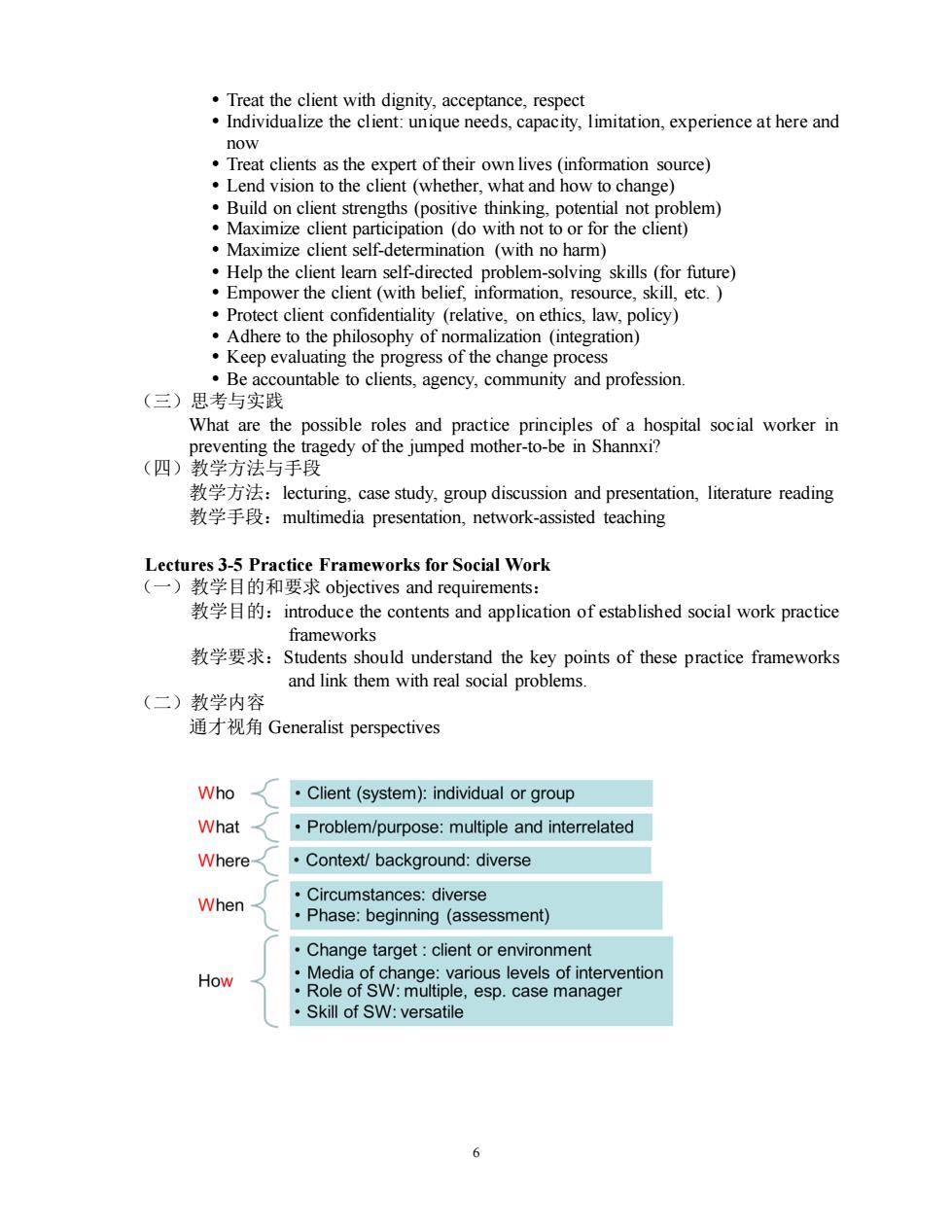
·lnd e the client:unique needs,capacity.limitation,experience at here and reat clients as the expert oftheir own lives(information source) Lend vision to the client(whether,what and how to change) Build on client strengths (positive thinking,potential not problem) Maximize client participation (do with not to or for the client) Maximize client self-determination (with no harm) Help the client learn self-directed problem-solving skills (for future) Empower the client (with belief,information,resource,skill,etc. Protect client confidentiality (relative,on ethics,law,policy) Adhere to the philosophy of normalization (integration) Keep evaluating the progress of the change process Be accountable to clients,agency,community and profession (三)思考与实践 What are the possible roles and practice principles of a hospital social worker in preventi 教学方法:lecturing,case study,group discussion and presentation,literature reading 教学手段:multimedia presentation,network-assisted teaching Lectures 3-5 Practice Frameworks for Social Work (一)教学目的和要求objectives and requirements:: 教学目的:introduce the contents and application of established social work practice frameworks 教学a要求:Students should understand the key points of these practice frameworks and link them with real social problems. (二)教学内容 通才视角Generalist perspectives Who Client(system):individual or group What Problem/purpose:multiple and interrelated Where- Context/background:diverse When .Circumstances:diverse Phase:beginning(assessment) Change target:client or environment How le,esp.case manager Skill of SW:versatile 6
6 Treat the client with dignity, acceptance, respect Individualize the client: unique needs, capacity, limitation, experience at here and now Treat clients as the expert of their own lives (information source) Lend vision to the client (whether, what and how to change) Build on client strengths (positive thinking, potential not problem) Maximize client participation (do with not to or for the client) Maximize client self-determination (with no harm) Help the client learn self-directed problem-solving skills (for future) Empower the client (with belief, information, resource, skill, etc. ) Protect client confidentiality (relative, on ethics, law, policy) Adhere to the philosophy of normalization (integration) Keep evaluating the progress of the change process Be accountable to clients, agency, community and profession. (三)思考与实践 What are the possible roles and practice principles of a hospital social worker in preventing the tragedy of the jumped mother-to-be in Shannxi? (四)教学方法与手段 教学方法:lecturing, case study, group discussion and presentation, literature reading 教学手段:multimedia presentation, network-assisted teaching Lectures 3-5 Practice Frameworks for Social Work (一)教学目的和要求 objectives and requirements: 教学目的:introduce the contents and application of established social work practice frameworks 教学要求:Students should understand the key points of these practice frameworks and link them with real social problems. (二)教学内容 通才视角 Generalist perspectives
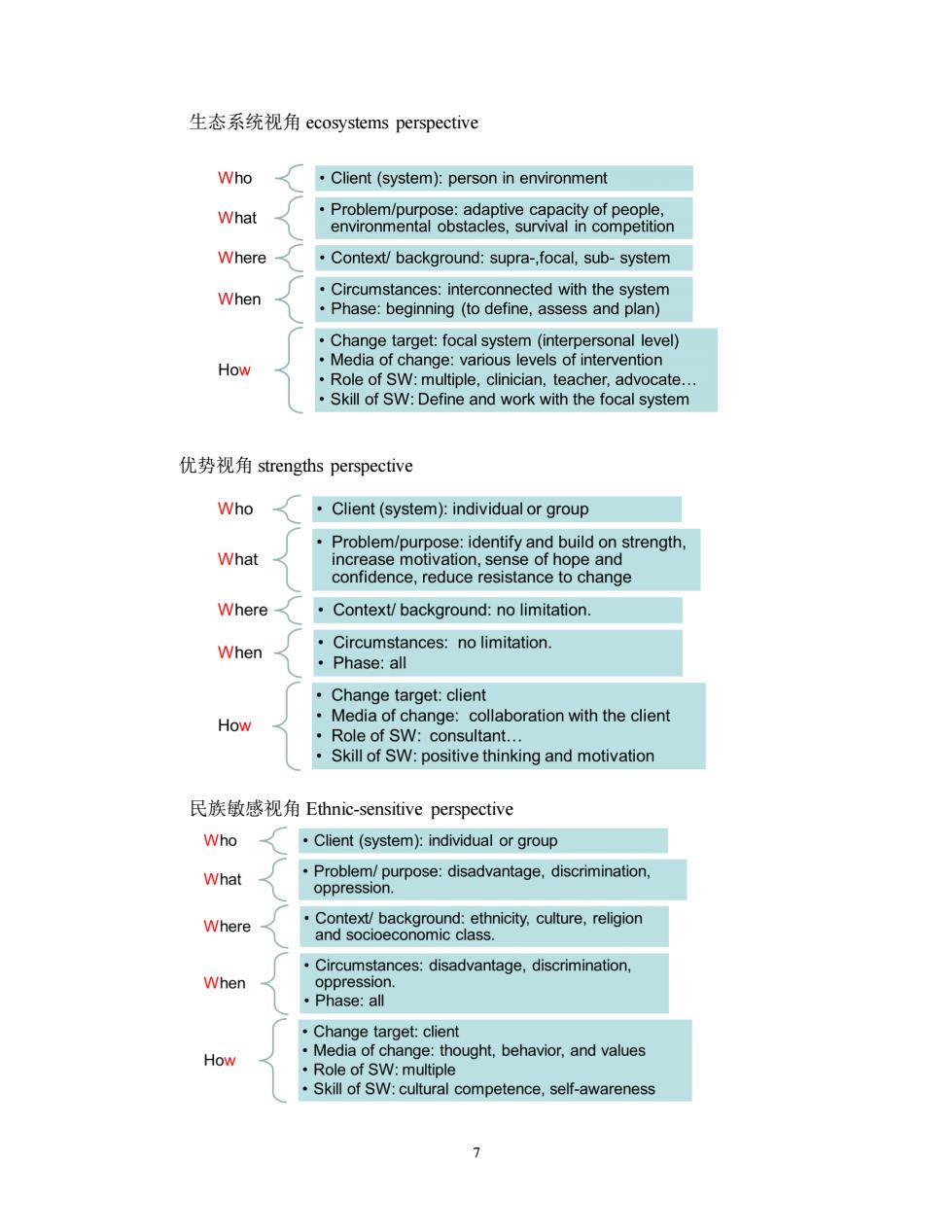
生态系统视角ecosystems perspective Who Client(system):person in environment What Problem/purpose:adaptive capacity of people, environmental obstacles,survival in competition Where .Context/background:supra-,focal,sub-system When ange target:focal system(inter ersonal level) How Role of SW: .Skill of SW:Define and work with the focal system 优势视角strengths perspective Who .Client(system):individual or group What Problem/purpose:identify and build on strength. Where Context/background:no limitation Wher :oan8aete How ange laboration with the client Skill of SW: 民族敏感视角Ethnic--sensitive perspective Who .Client(system):individual or group What 8pee2urpoedsa0vanage.dscmrnaion Where ethnicity,culture,religion Circu mstances:disadvantage,discrimination. When oppression. ·Phase:al How n Role of SW: ultiple ought,behavior,and values Skill of SW:cultural competence,self-awareness
7 生态系统视角 ecosystems perspective 优势视角 strengths perspective 民族敏感视角 Ethnic-sensitive perspective
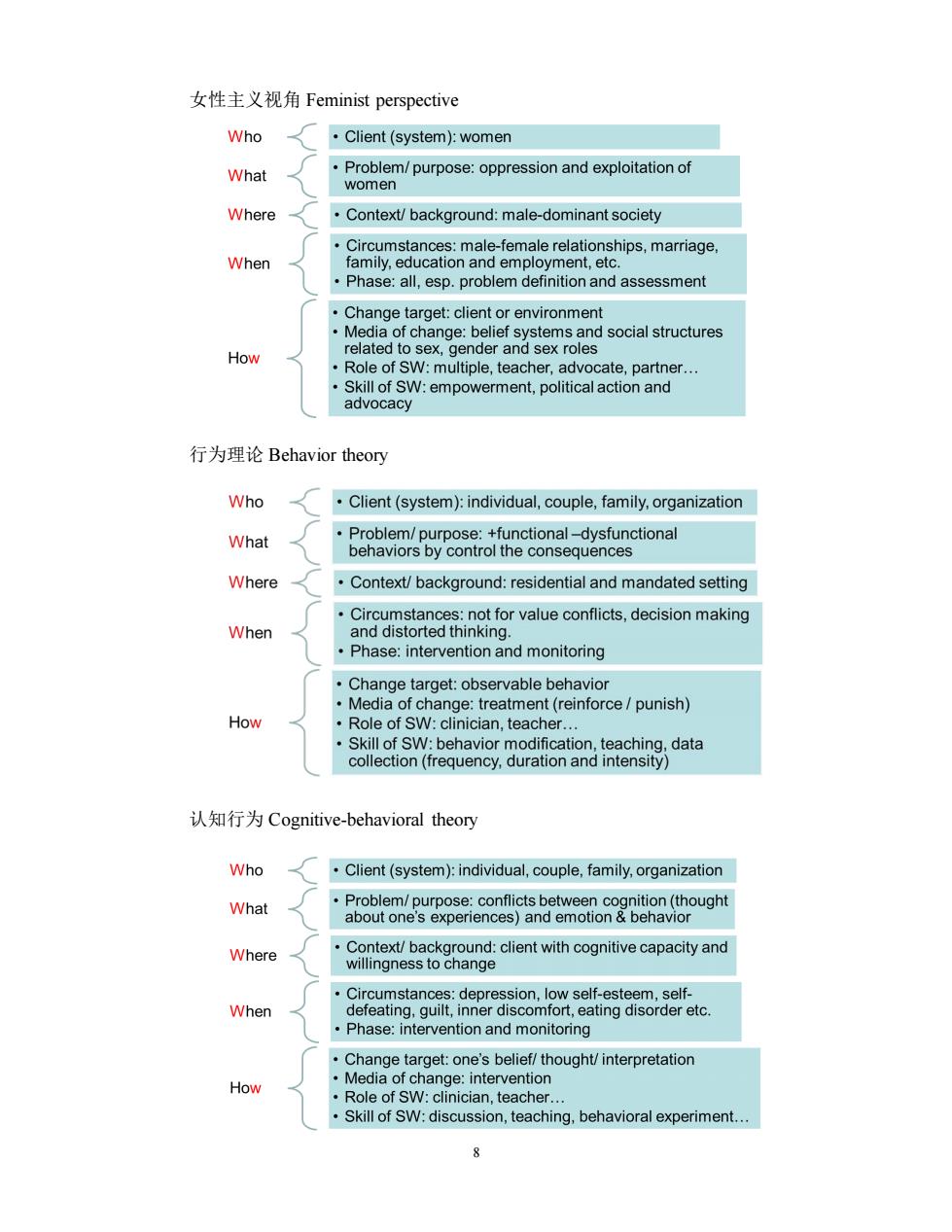
女性主义视角Feminist perspective Who .Client(system):women What Problem/purpose:oppression and exploitation of Where Context/background:male-dominant society When ·8msammseeahps.marmeoe Phase:all,esp.problem definition and assessment How Role of SW:multiple,teacher,advocate,partner. iof SW:empowerment.political action and 行为理论Behavior theory Who Client(system):individual,couple,family,organization What Where Context/background:residential and mandated setting When Phase:intervention and monitoring Change target observable behavior Media of change:treatment (reinforce/punish) How Role of SW:clinician,teacher... 认知行为Cognitive-behavioral theory Who .Client(system):individual,couple,family,organization What Where :Cigs2gaentwihcogntvecapaecyand When et Change target:one's belief/thought/interpretation How Media of change:intervention Role of SW: clinician,teacher Skill of SW:discussion,teaching,behavioral experiment
8 女性主义视角 Feminist perspective 行为理论 Behavior theory 认知行为 Cognitive-behavioral theory
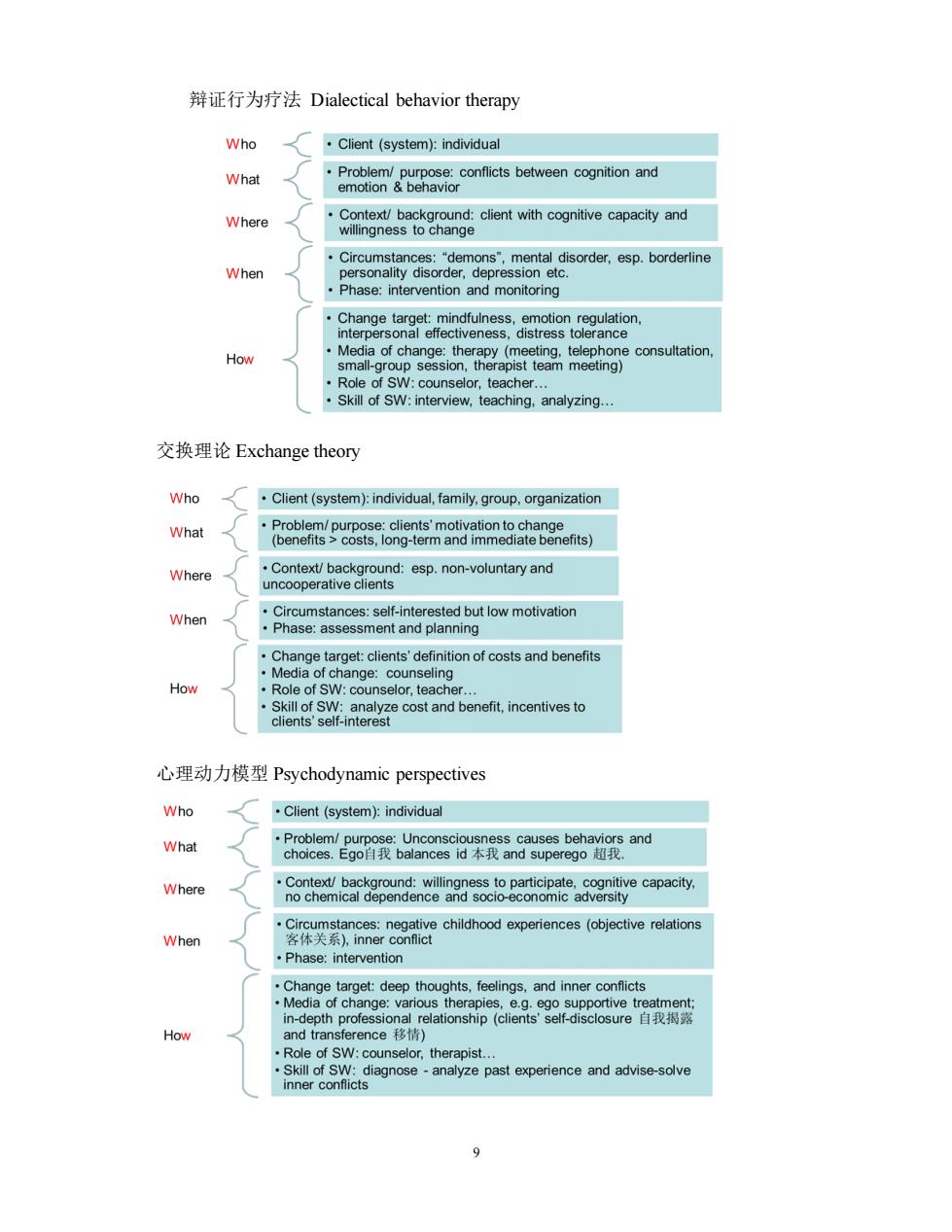
辩证行为疗法Dialectical behavior therapy Who Client (system):individual What conflicts between cognition anc Where client with cognitive capacity and When Phase:intervention and monitoring How e consultation ching.analyzing. 交换理论Exchange theory Who .Client(system):individual,family.group,organization What Where When How Role of SW:counseor,teacher 心理动力模型Psychodynamic perspectives Who Client(system):individual What Where When Phase:intervention .Ch How and transference移情) nmercocgiagnose analyze pas experience and advise-solve
9 辩证行为疗法 Dialectical behavior therapy 交换理论 Exchange theory 心理动力模型 Psychodynamic perspectives
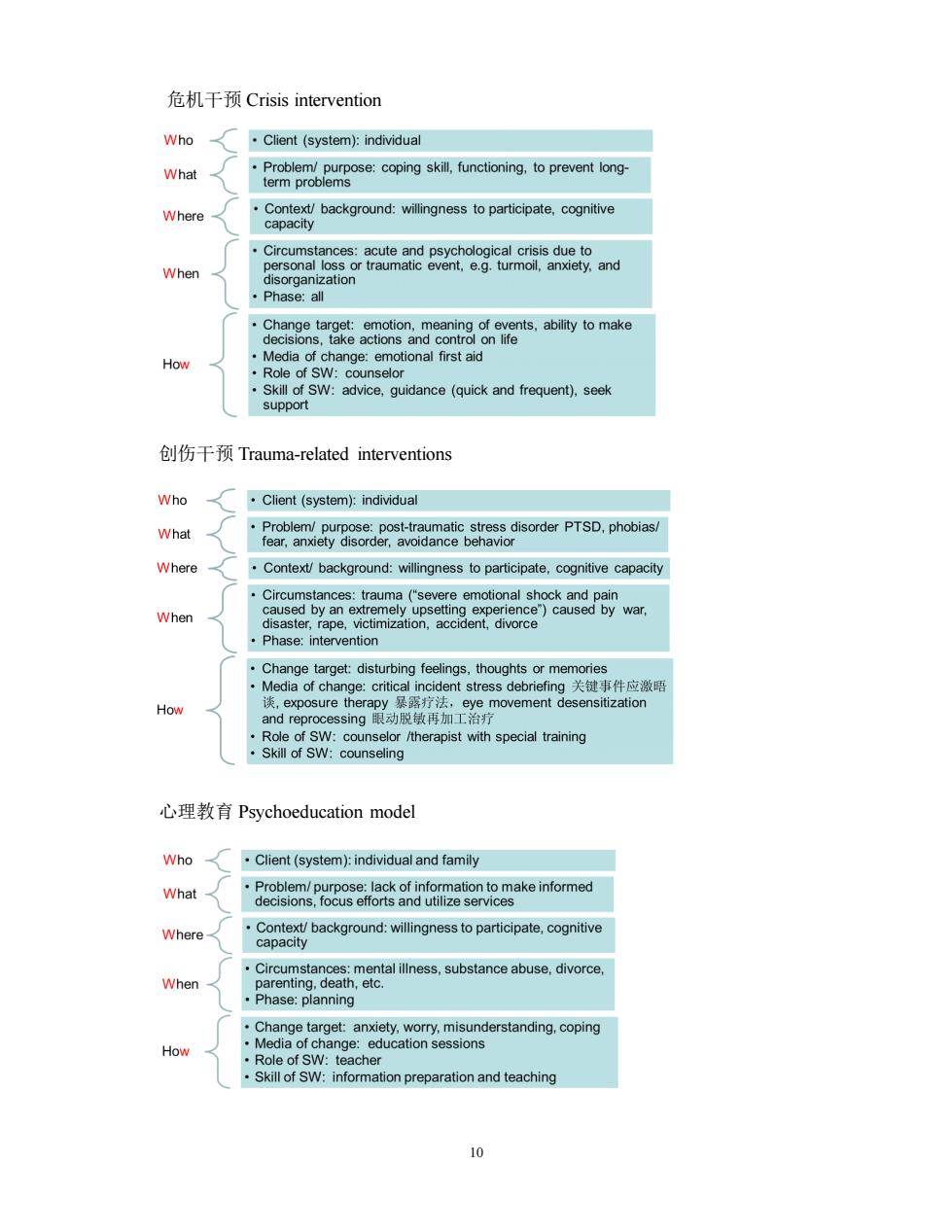
危机千预Crisis intervention Who Client (system):individual What Where Cpeybackgrountwingnessiopatcpaacogntve When 96ee8eng6mcgrngeant8c8s,byomaka How tional first aid kill of W:advice,guidance (quick and frequent),seek suppor 创伤干f预Trauma-related interventions Who Client(system):individua What Where Context/background:willingness to participate.cognitive capacity caused s:trauma ( When Phase:intervention Change target:disturbing 性应 How o/therapist with special training Skill of SW:counseling 心理教育Psychoeducation model Who Client(system):individual and family What Where. :Cpgeybacgoundtwngnestoparicpale,cogntve circu When .Change target:anxiety.worry.misunderstanding.coping How Role of SW: 8ac8rucationsesions Skill of SW:information preparation and teaching
10 危机干预 Crisis intervention 创伤干预 Trauma-related interventions 心理教育 Psychoeducation model